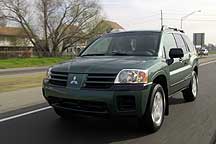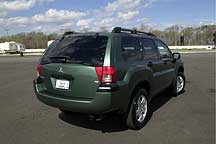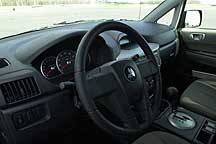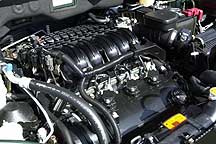Car Review 2004 Mitsubishi Endeavor Mid-Size Sport Utility Vehicle

MSRP Range: LS: $25,000 to $28,000, XLS: $28,000 to $32,000, LTD: $32,000 to $35,000
Invoice Range: LS: $23,500 to $27,000, XLS: $25,500 to $28,000, LTD: $29,000 to $31,000
MSRP As Tested: $32,000
Versions: LS, XLS, LTD all three available with either Front-Wheel Drive, Four-Wheel Drive or All-Wheel
Vehicle Category: Mid-Size Crossover Sport Utility Vehicle
Engine Location: Front Engine
Drive Wheels: Front-Wheel Drive, Four-Wheel Drive or All-Wheel
Engine As Tested: 3.8-liter, Single Overhead Cam, V6, 215-horsepower at 5,000 rpm and 250 lb-ft torque at 3,750 rpm
Transmission As Tested: 4-Speed Automatic with manual shift mode
Fuel Economy (city/hwy): Four-Wheel Drive: 19/29, All-Wheel Drive: 19/27
Standard Safety Features: Driver and Front Passenger, front airbags, power 4-wheel disc brakes, Antilock Braking System, Electronic Brake Force Distribution
Competition: Chevrolet TrailBlazer, Ford Explorer, GMC Envoy, Honda Pilot, Isuzu Axiom, Toyota Highlander.
(New Orleans, Louisiana) - We are in the bayou country near the Big Easy test driving the all-new, 2004 Mitsubishi Endeavor, their new, mid-size, crossover Sport Utility Vehicle (SUV.) This is a great region for test driving vehicles. It is scenic, the roads conditions range from horrendous to spectacularly smooth , and weather conditions change all the time, providing ample opportunity to see what a vehicle can handle.
History
Until recently Mitsubishi's vehicle development efforts focused on SUVs with real off-road capabilities, built on truck platforms. Mitsubishi now wants to sell products to buyers who whan the utility of an SUV, without the truck-like ride. Crossovers, as they are called, are seen as a tremendous sales opportunity. Mitsubishi now has a nearly full compliment of products for these buyers with the introduction of the compact Outlander, and now the mid-size 2004 Endeavor. There are two more, larger SUVs in the line, the Montero Sport and Montero. Both are built on truck platforms.
Endeavor is built on a brand new unibody, front-engine platform. It is more like a passenger sedan in design. Unline trucks which are built on a platform that look like a ladder on a frame. Buyers can choose between the standard front-wheel drive, or optional full-time all-wheel drive versions.
Endeavor has seating for five adults. There is no third row available. Perhaps this may hurt sales a little in the family-vehicle market where the number of people a vehicle can carry is much more important than off-roading capability.
Endeavor comes in three trim levels, the entry level LS, the mid-range XLS and the luxury LTD.

Vehicle Exterior
Endeavor's exterior styling is based on Mitsubishi's SSU concept car from a few years back. It features a large, split, front grill with a very large company logo on it -- not very attractive. The lines of the grill's split continue up and across the hood forming a trianglae. Large rectangular headlights are mated to highly arched front wheel wells. The backend has a large tailgate with a hinged rear window. This is convenient when stowing something in the cargo area and there isn't enough space to open the tailgate. The hinged window is also great for getting smaller things in and out of the cargo area, or when long items demand extra space.
The styling is one of the best offered by Mitsubishi. The rear three quarter view is particularly attractive. It is far more contemporary looking than the Montero Sport, and significantly less "science fiction, other-worldly" than the Montero. Mitsubishi wanted Endeavor to look as if it belonged in the same category as the BMW x5 and Mercedes-Benz M Class., lloking less like its Japanese competitors and more like a European product.
The split grill, introduced on Outlander, is now part of the Mitsubishi design DNA. It will also be on the new Galant. Unfortunately that is the least attractive componet of Mitsubishi's design. It is bulbous and heavy. It looks more like a battering ram, or cow catcher, than the strong design element Mitsubishi claims it is. This design faux pas aside, if you choose to purchase an Endeavor you will be able to park near Mercedes and BMWs, and not feel like the poor kid on the block.

Vehicle Interior
The instrument cluster is clean and easy to see. There are three interlocking gauges in the cluster. On the right is a large analog tachometer. The left contains the fuel, water temperature and transmission position gauges. There is a large analog speedometer in the center.
The large center stack has a metallic finish. It looks out of place. Everywhere else inside the vehicle the surfaces are smooth and attractive. Mitsubishi has a habit of putting at least one unnecessary and out-of-place design cue in the interior and exterior of almost every vehicle they make.
The controls in the center stack are in the right places, and easy to find. At the top is a screen displaying information for the entertainment system, climate controls and clock. Below are the switches for the entertainment system. Underneath, where they should be, are the controls for the climate control system. There are also two large cup holders, big enough for water bottles.
The seats are very comfortable. They fit right and don't cut off circulation. We drove for hours on rural Louisiana roads and were relaxed and rested when we finished the test drive. Opt for the leather seating surfaces. They are easier to clean, more comfortable and very attractive.

Performance
Endeavor's engine in an updated version of the same 3.5-liter, single overhead cam powering the Montero Sport. It delivers 215-horsepower and 250 lb.-ft. of torque. It has no problem moving Endeavor's 5,000 pounds. The vehicle accelerates quickly from a stop and merges onto the freeway comfortably. The engine is quiet when crusing, but when you step on the gas the engine note says "let's go." And it does.
The towing capacity of the two-wheel drive version is only 2,000 pounds. That's a little weak. The all-wheel drive version tows 3,500 pounds, which is competitive with vehicles like the Lexus RX330.
Endeavor gets 17 miles to the gallon in the city for both the 2-wheel and all-wheel drive versions. On the highway the two-wheel drive gets 23 miles to the gallon, and the all-wheel drive gets 21.
Ride and Handling
This is where Endeavor shines. Mitsubishi has developed a platform that delivers a very smooth ride compared to most SUVs and trucks. This is due, predominantly, to the use of a unibody construction, like those used on passenger cars. On a slow, bumpy drive out of New Orleans, on a very beat up road, Endeavor reduced the jolts into minor annoyances. (Look at the car-to-car photos for proof.) The ride is on par with most competitors, and better than the Toyota Highlander, Buick Rendevous, Pontiac Aztek, and the more expensive Lexus RX 330.
During the test drive Mitsubishi had us in a dry river bed to demonstrate the off-road ride. This was a good example, as it is the kind of off-roading most of us will do: driving on a dirt road. It did just fine in this condition and handles the mud puddles without incident. But if you plan on doing any serious off-roading, consider the Mitsubishi Montero instead.
Safety
Endeavor comes with all the standard safety features expected. Standard on all models are depowered, driver and front-passenger airbags. Standard on most versions are side-impact airbags. These are optional on the XLS. No head curtain airbag is available. The Endeavor Limited can be equipped with Mitsubishi's optional Mitsubishi Anti-skid and Traction Control system (M-ASTC.) It should be available to all trim levels, but isn't for some odd reason. A tire pressure monitoring system is included on the Limited. Sensors monitor the tire pressure of all four wheels activating a warning light if tire pressure falls below 25.25 PSI , if a system component is damaged, or if the sensor battery is low.
The Endeavor has not yet been tested by either the Insurance Instituite for Highway Safety (IIHS) or National Highway Traffic Safety Administration (NHTSA) for crashworthiness. We hope the unibody construction will fair better in the tests than some previous Mitsubishi products. The unibody design provides better crush zones than the body-on-frame chassis used for most trucks and large SUVs. According to Mitsubishi research, the Endeavor will meet, or exceed, federally mandated performance in the 30-mph frontal, 30-mph oblique and 35-mph rear-collision tests.
In Conclusion
The Endeavor is a good mid-size crossover Sport Utility Vehicle. It should sell well. Does it beat the competition? Yes, in some ways. It has the high seating position everyone seems to want, it handles well, it's comfortable with the ride of a Mitsubishi Galant -- a greatly under appreciated vehicle.
Pros: Distinctive styling. Good ride. Handles well. Has a decent interior. Is a good value for the money.
Cons: No third row seat for those who need it. The out of place metal finish on the center stack. Limited towing capacity.
MORE DATA
Where Built: USA
Seating: 5
Number of Rows: 2
Crash Test Ratings:
- NHTSA Frontal Impact/Driver Crash Test Rating: Untested
- NHTSA Frontal Impact/Passenger Crash Test Rating: Untested
- NHTSA Side Impact/Front Seat Crash Test Rating: Untested
- NHTSA Side Impact/Rear Seat Crash Test Rating: Untested
- NHTSA Rollover Resistance Rating: To Be Determined
- IIHS Frontal Offset Crash Test: Untested
Length in Inches: 190.2
Warranties: 3 years/36,000 miles bumper-to-bumper, 7 years/100,000 mile corrosion, 5 years/60,000 mile powertrain
Weight in Pounds: 4,079
Towing Capacity in Pounds: 3,500
Payload Capacity in Pounds: 1,094 to 1,203
Gas Tank Capacity in Gallons: 21.4
Destination Charge: $595




